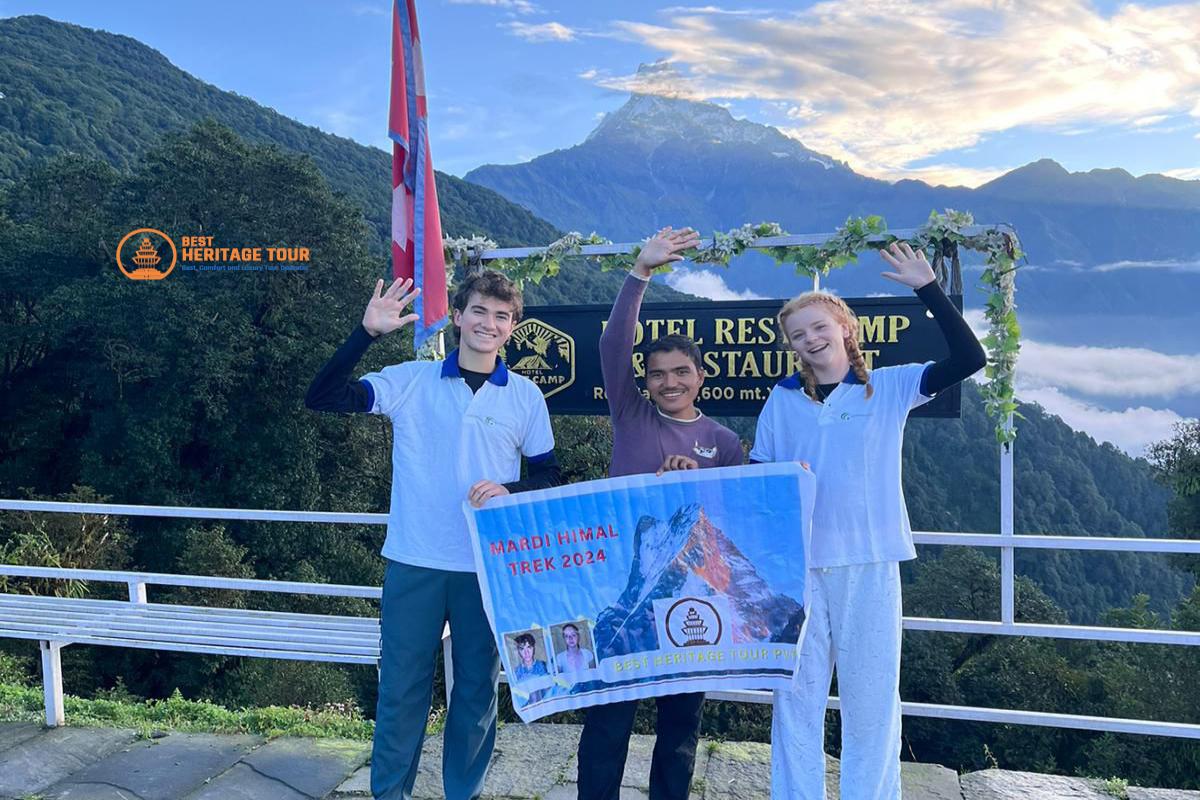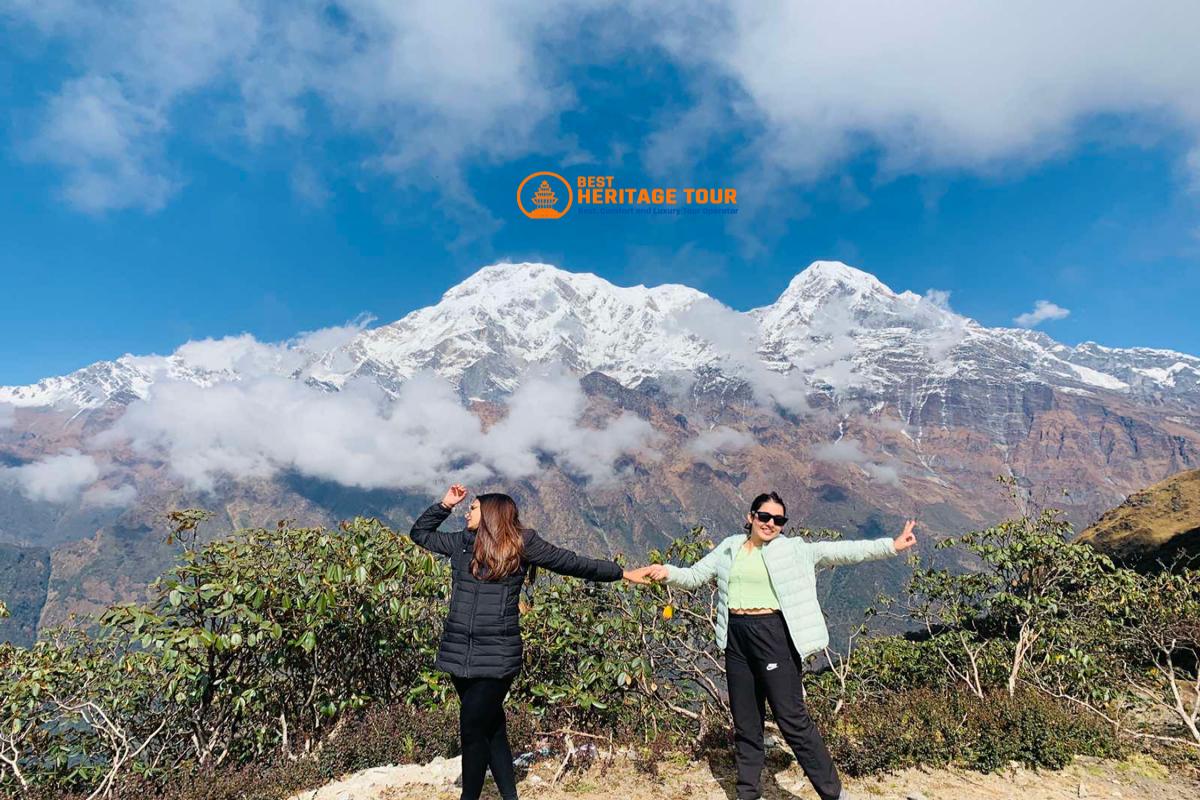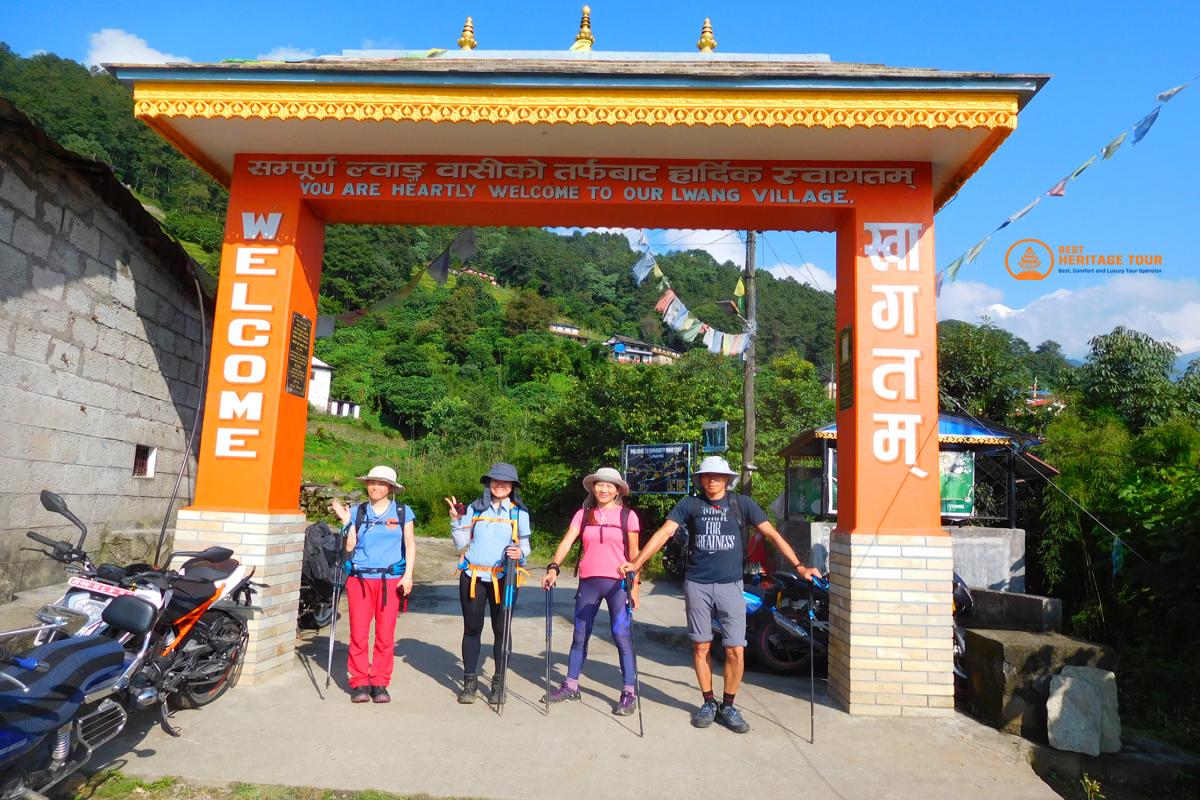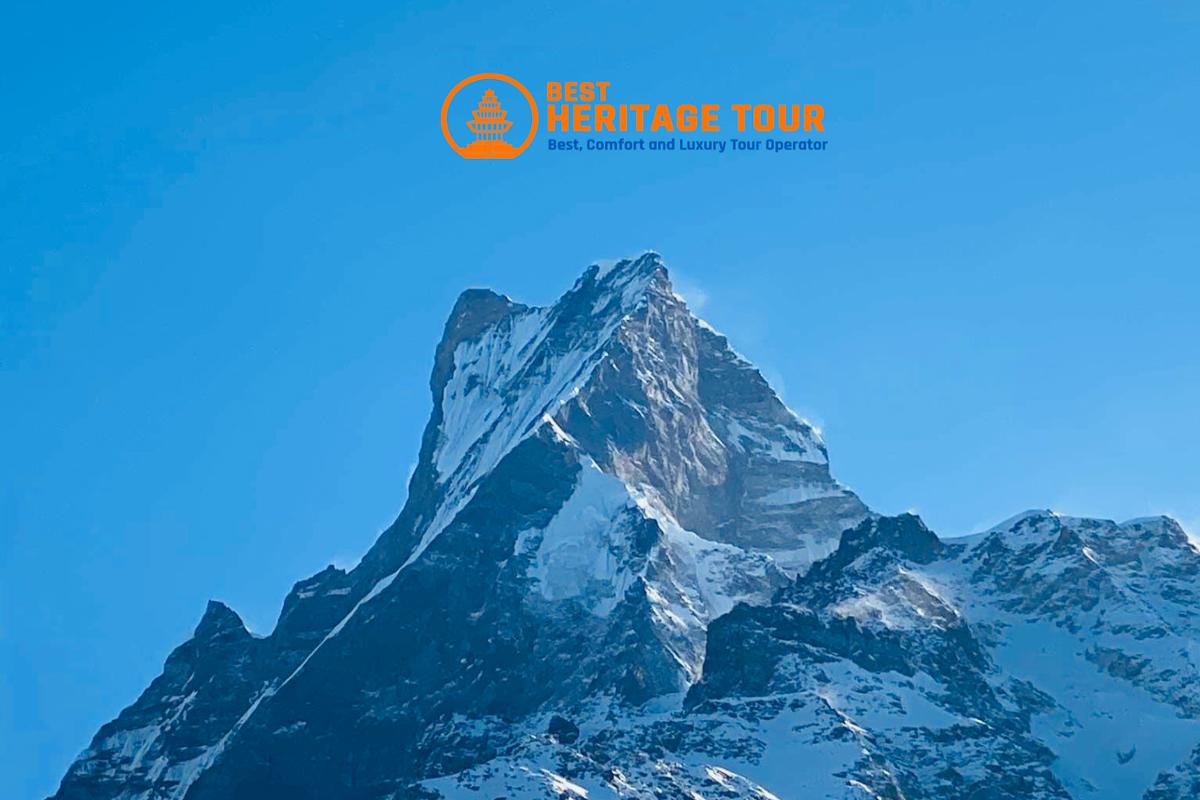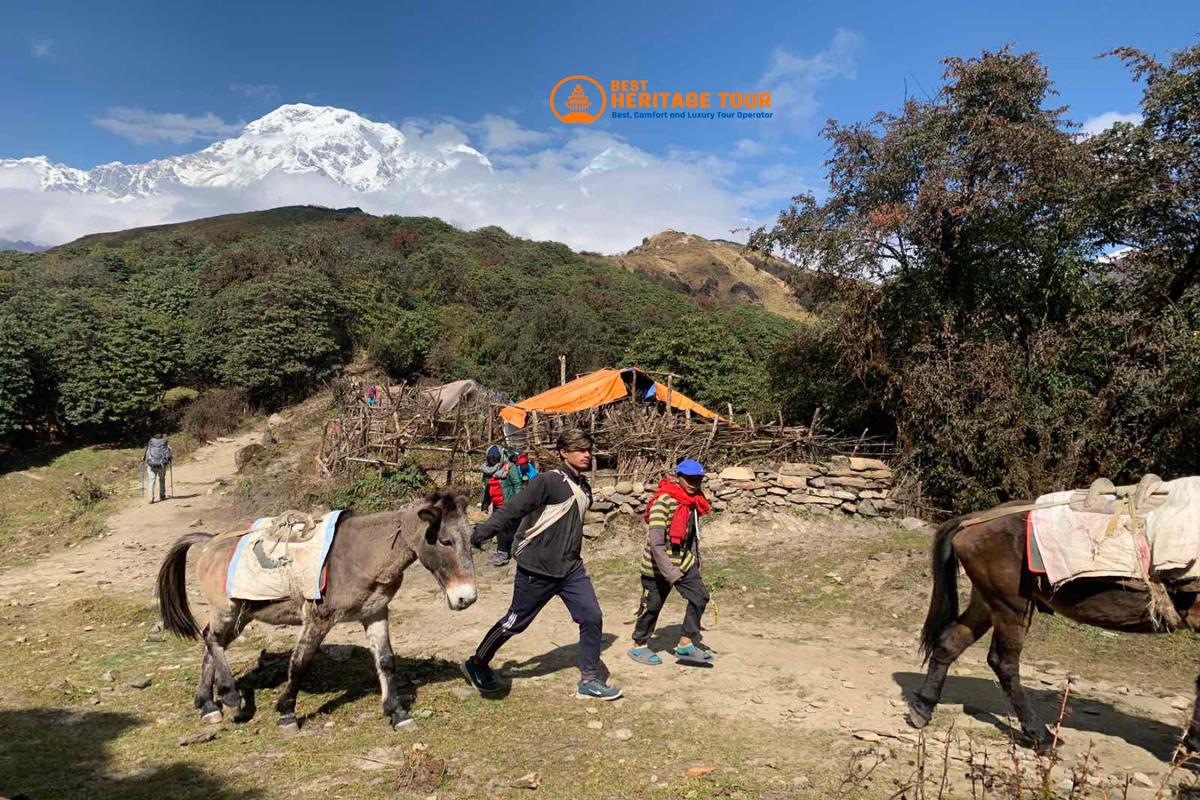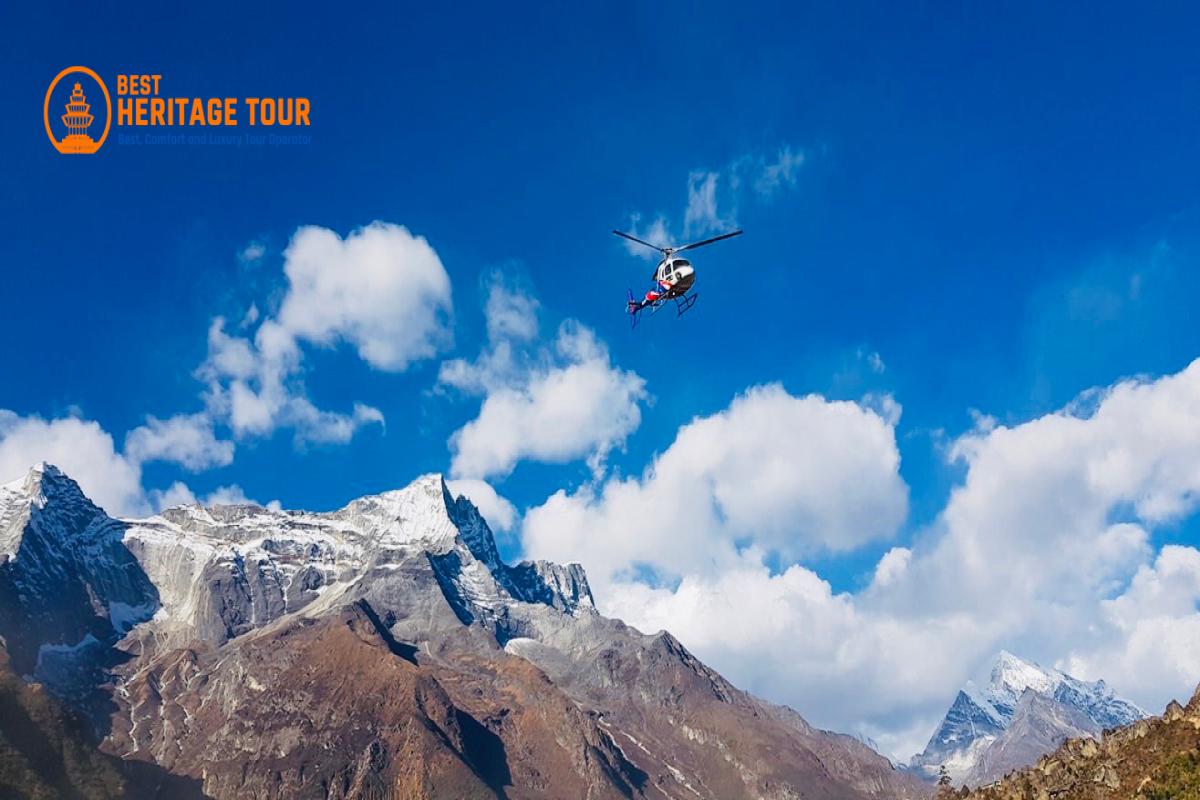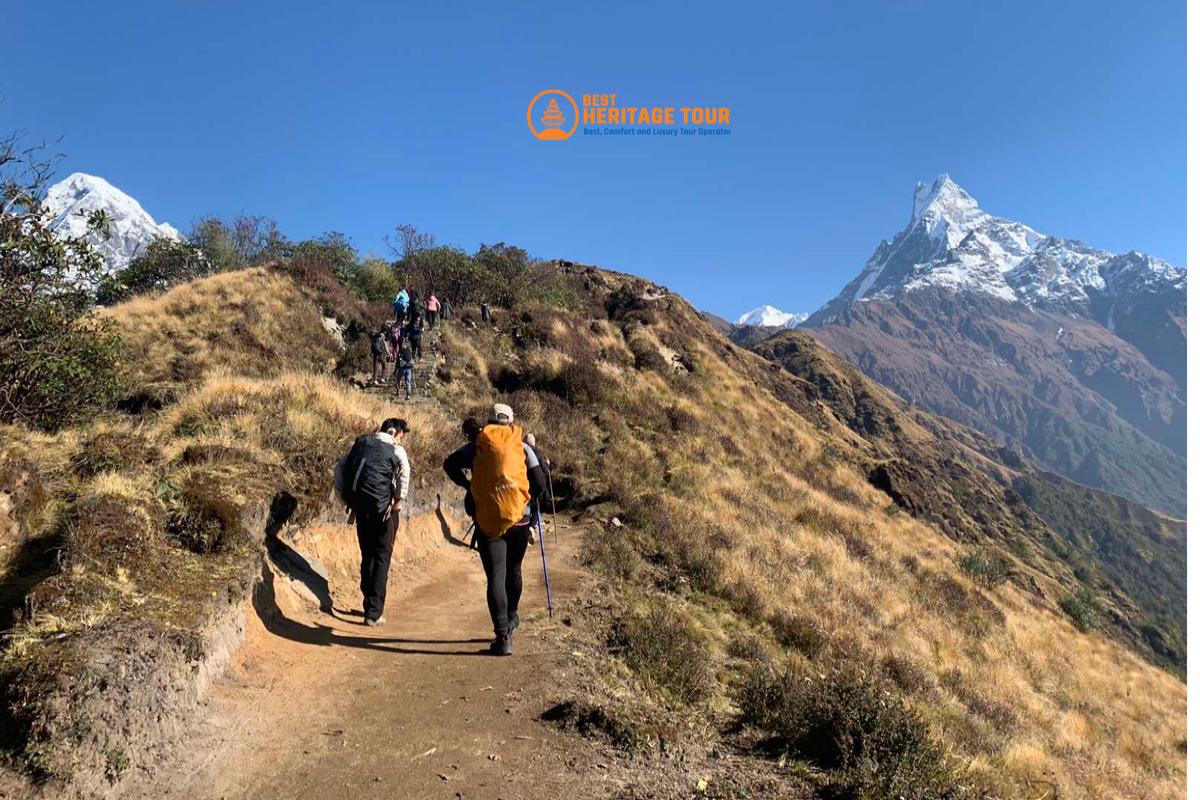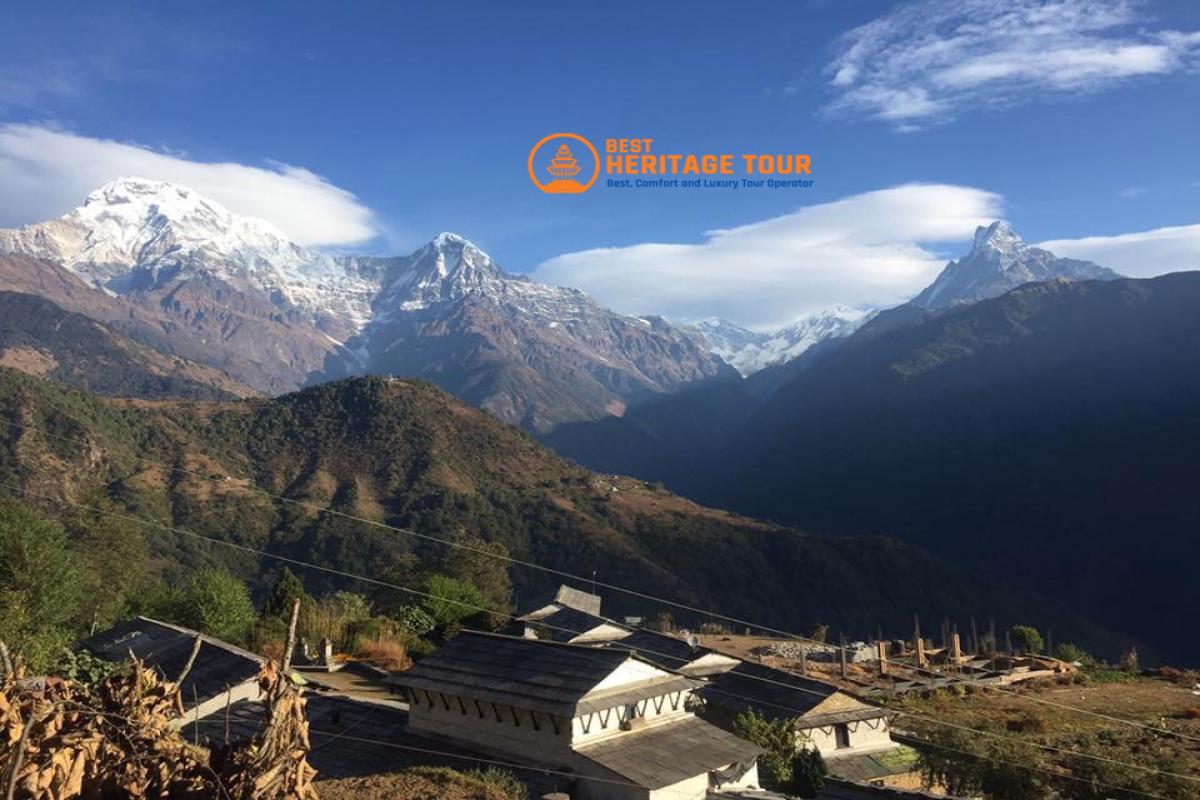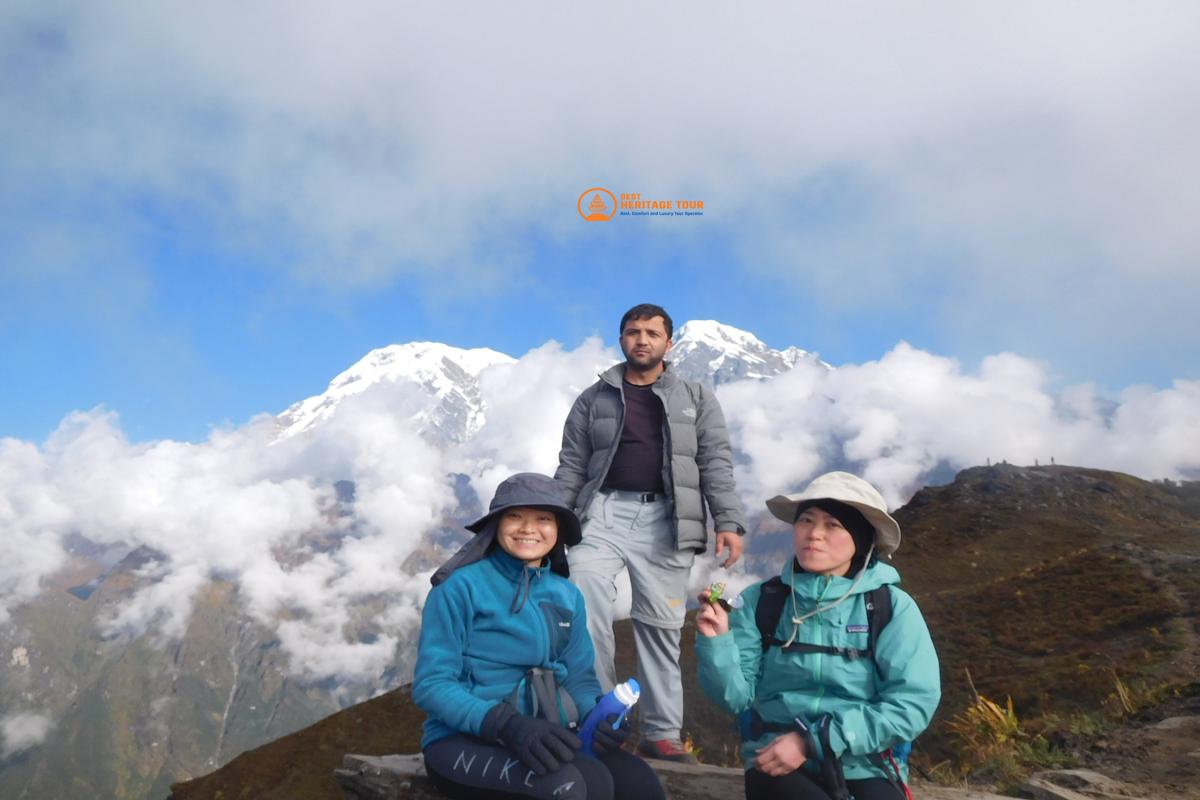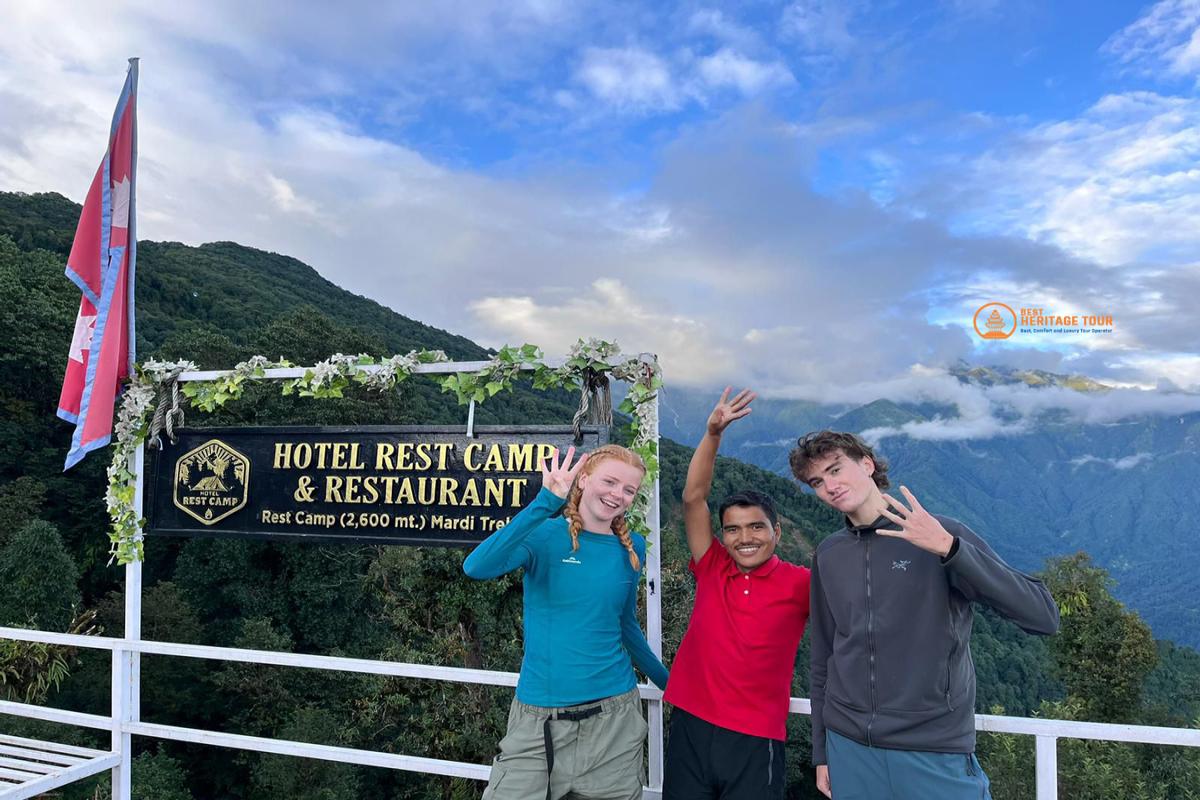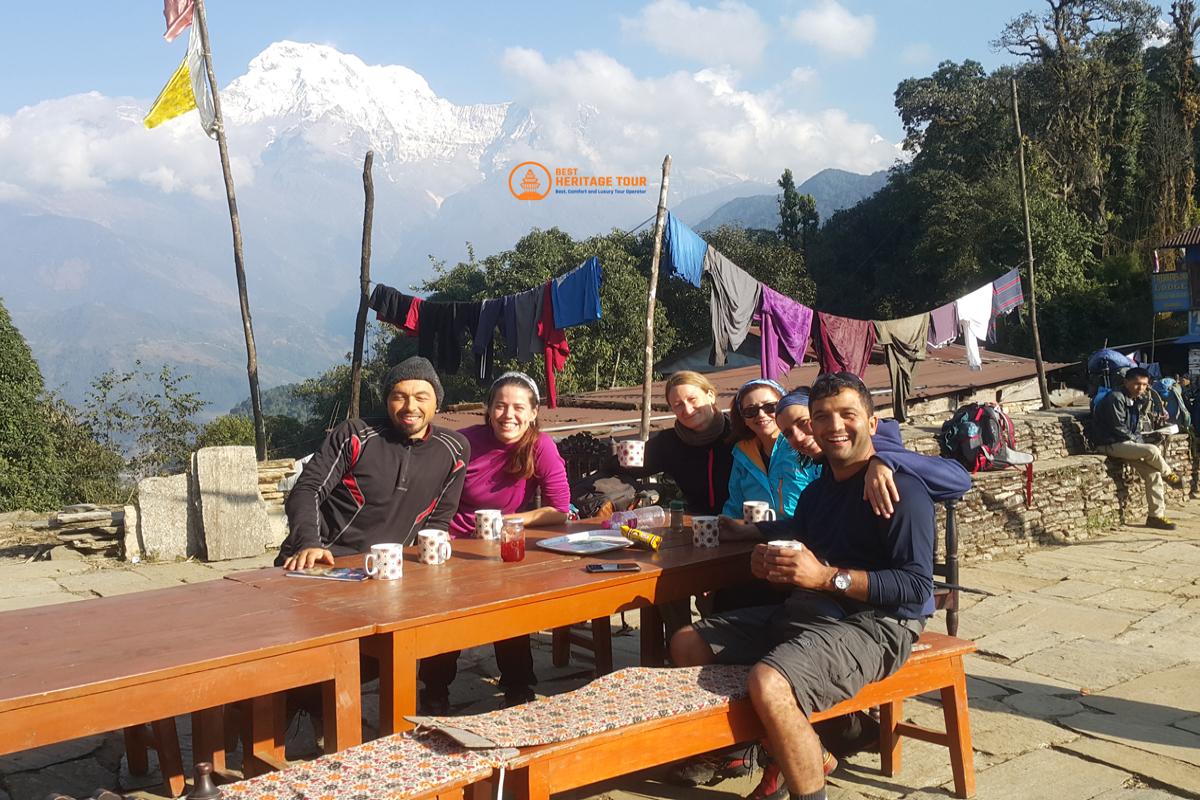Mardi Himal Trek - 7 Days
Insights on the Mardi Himal Trek
Embark on the Mardi Himal Hike, leading you to the Mardi Himal Base Camp at 4,500m/14,763ft. This trek navigates through uncharted paths, showcasing stunning scenery, quaint rural communities, verdant forests, striking high alpine landscapes, and untouched wilderness against the backdrop of the towering snow-covered peaks - Annapurna, Machhapuchre (Fishtail), and Hiunchuli.
Trip at a Glance
Key Features of Mardi Himal Expedition
- Explore Pokhara - the bustling tourist hub of Nepal
- Mardi Himal Base Camp at an impressive altitude of 4,500m
- Enjoy rejuvenating hot springs at Jhinu Danda
- Ideal for individuals of all age brackets
- Visit Mardi Himal High Camp (3,600m), Low Camp, and Forest Camp (2600m)
- Immerse yourself in an authentic rural Nepali village experience
Benefits of the Mardi Himal Expedition in conjunction with the Best Heritage Tour
- Convenient booking and reservation process
- Virtual trip briefing post booking confirmation
- Various communication channels (Email, WhatsApp, Facebook, WeChat, Viber, Skype, Zoom)
- 24/7 phone assistance at +977- 9851149197/+9779810043046
- Simple payment method
- Complimentary private airport transfers to/from the hotel
- Oximeter for monitoring blood oxygen levels at high altitudes and medical kits
- Provision of sleeping bags and down jackets if needed
- Duffle bag for the porters
- Free storage for extra luggage at the Best Heritage Tour store during the trek.
Online Trip Briefing
Our online briefing will address all your inquiries regarding the trek, such as the necessary equipment checklist, detailed itinerary, and the experiences you can anticipate on the trails. Upon booking completion, we will promptly send you the trek briefing schedule options via email. Once we have received your required documents, we will proceed with the online trek briefing.
Business travel package
Experience the unparalleled and exclusive journey of the Mardi Himal Trek in the breathtaking Annapurna region.This trek showcases the best of what Nepal has to offer - picturesque rural villages, breathtaking landscapes, majestic snow-covered peaks, and diverse flora and fauna leading you to the Mardi Himal Base Camp at 4,500m (14,763ft). During the journey, you will be able to enjoy breathtaking views of Annapurna South, Mount Machhapuchre, and Mount Hiunchuli. Considered as an alternative to the traditional Annapurna Base Camp trek, the Mardi Himal Trek provides a different perspective with its unspoiled beauty. Despite being a modest peak at 5,587m (18,330 ft) compared to other towering mountains in the region, Mardi Himal has a unique allure that attracts adventurers seeking a less crowded destination. This trek is suitable for both beginners and experienced trekkers, offering a memorable journey with stunning views of Annapurna I and Machhapuchre.
The journey commences with a six-hour drive from Kathmandu to Pokhara. The next day, we will travel from Pokhara to Dhampus, where we will begin our trekking adventure. Our goal for the day is to reach Deurali, passing through various small ethnic villages along the way.
Upon waking up at Deurali on the third day, we will traverse a dense forest teeming with rhododendron, birch, oak, maple, hemlock, and daphnia on our way to Forest Camp. This forest is home to leopards, deer, monkeys, and a variety of bird species. Upon arrival at Forest Camp, you will be treated to breathtaking views of Mt. Machapuchre and Mardi Himal.
The following day, we will be leaving Forest Camp to head towards High Camp. The trails are quite steep, becoming narrower and more challenging as you ascend. On your left, you will have a clear view of the Modi Khola River valley, and on your right, you will be able to observe the Mardi Khola and Seti River valleys. On clear days, you may even catch a glimpse of Pokhara from the trails. After reaching High Camp (3,900m), we will spend the night at a lodge. On the fifth day of your trek, you will reach the Mardi Himal Base Camp. Starting from High Camp, you will climb until you reach the base camp at 5,300m, where you can marvel at the spectacular views of the Annapurna range. Following this, we will descend to Low Camp (3,050m), making for an easier trek as we go downhill.
Commencing from Low Camp, we will embark on our journey towards Jhinu Danda. The expedition promises to be delightful as we traverse through the picturesque Gurung settlement of Landruk. Jhinu Danda boasts natural hot springs, a perfect opportunity for a rejuvenating soak.
The following day, we will rise at Jhinu Danda, trek to Siwa / Ghardruk Phedi, and subsequently travel to Pokhara via Nayapul. We are confident that you will find great satisfaction in this Annapurna region trek. Your trekking experience concludes upon reaching Pokhara.
The Mardi Trek commences with a 6-7 hour bus journey from Kathmandu to Pokhara, a complimentary inclusion in the package. Alternatively, clients have the option to upgrade to a 20-minute flight to Pokhara at an additional cost. We kindly ask our esteemed clients to ensure their arrival in Kathmandu before 3 pm on the day prior to the trek departure for final preparations. In the event that you missed the online trip briefing, this will allow us the opportunity to arrange an in-person briefing.
Itinerary
Travel Time
(200km / 124miles) 6 to 7 hrs
Following an early breakfast, we will board a tourist bus bound for Pokhara. The journey will last six to seven hours. Along the route, you will pass by the scenic Trishuli and Marsyangdi rivers. Pokhara is a charming valley nestled beside the Phewa Lake, renowned for its breathtaking views of the Annapurna ranges, Machapuchare to the north, Dhaulagiri to the west, Manaslu and Lamjung Himal to the east. Pokhara offers a plethora of tourist attractions and modern conveniences.
Complimentary breakfast is provided for your convenience.
Estimated Driving Time: 3-4 hours
We will depart early in the morning for a 2-hour drive to Dhampus, the starting point of our journey. The trek will lead us through traditional Brahmin, Magar, and Gurung villages, offering stunning views of the Annapurna mountain range. Passing through rhododendron forests and reaching Pothana, we will finally arrive at Deurali (2100m). Here, you will have the opportunity to witness the majestic Annapurna South peak and its towering glaciers from a distance.
Accommodation for the night will be provided in a lodge, with meals included (Breakfast + Lunch + Dinner).
Trek Distance: 6km / 3.7miles
Departing from Deurali bright and early, we make our way towards Forest Camp. The trail steadily climbs through a variety of forests including rhododendron, birch, oak, maple, and hemlock. Keep your eyes peeled for glimpses of wildlife such as leopards, deer, monkeys, and various bird species along the way. Our accommodation for the night will be at Forest Camp.
Accommodation for the night will be provided in a lodge, with meals included (Breakfast + Lunch + Dinner).
Trek Distance: 8.5km / 5.2miles
The trek today involves moving from Forest Camp to High Camp via Low Camp. The terrain is challenging, but the panoramic views of Machhapuchhre (fishtail mountain), the Annapurna Range, the Annapurna Base Camp valley, and Mardi Himal make it worthwhile.
After a few hours of trekking, the forest clears up, revealing the majestic Annapurna South. The path then transitions into a mix of scrub forest and open meadows.
As we climb higher, the ridge becomes narrower, providing glimpses of steep valleys on either side. To the left, you can overlook the Modi Khola river valley with villages leading to the Annapurna Sanctuary. To the right, the Mardi Khola and Seti river valleys come into sight. On clear days, even the Pokhara Valley is visible. We continue along the narrow ridgeline to High Camp (3900m) for an overnight stay.
Accommodation for the night will be provided in a lodge, with meals included (Breakfast + Lunch + Dinner).
Trek Distance: 10km / 6.2 miles
Getting up early at High Camp to see the stunning sunrise above the grand Himalayas. Proceed along the narrow ridge to reach Mardi Himal Base Camp at 4500 meters. Experience the breathtaking panoramic view of Annapurna South and Fishtail Mountain. After a brief stay at the base camp, descend to High Camp for lunch and then continue down to Low Camp for the night.
Accommodation for the night will be provided in a lodge, with meals included (Breakfast + Lunch + Dinner).
Trek Distance: 12km / 7.4miles
We will be descending from Low Camp on a steep trail through the forest. After an hour of hiking, we will reach a wide clearing for a brief rest. The descent will then take us to the hillside village of Siding, situated 500 meters above the river valley. The trek will pass through the Gurung settlement of Landruk. Depending on circumstances, we may stay in Landruk or proceed to Jhinu Danda. Jhinu Danda is known for its natural hot springs, providing a relaxing experience for tired muscles.
Accommodation for the night will be provided in a lodge, with meals included (Breakfast + Lunch + Dinner).
Trek Distance
4km / 2.4 miles
Driving Hours
2-3 hrs
Today concludes our trekking expedition.We will embark on a pleasant hike along the Modi River, making our way to Siwa/Ghandruk Phedi. After bidding farewell to the trails, we will drive back through the scenic countryside to Pokhara.
Accommodation for the night will be provided in a lodge, with meals included (Breakfast + Lunch ).
What is included?
- Roundtrip transportation between Kathmandu and Pokhara on a tourist bus
- Private transportation roundtrip from Pokhara to Dhampus (trek start) and Ghandruk Phedi (trek end) to Pokhara.
- Two nights accommodation with breakfast (room with attached bathroom) in Pokhara
- Lodging (for a total of five nights): Two nights in a room with a private bathroom at Deurali, Jhinu Danda. Three nights in a standard room at Forest Camp, High Camp, Low Camp (Usually shared with another person).
- All standard meals (7 lunches, 6 dinners, and 7 breakfasts) during the trek
- Government Licensed and experienced trek leader (guide), assistant trekking guide for a group of 12 or more trekkers Porters to help trekkers luggage (1 porter for two trekkers, luggage limit 8 kg per trekker)
- Guides and porters costs - meals, insurance, salary, lodging, transportation, and other necessary equipment
- Annapurna Conservation Area Permit (ACAP) fee
- Trekkers Information Management System (TIMS) card fee
- Snacks (cookies) and seasonal fresh fruits every day Water purification tablets for safe drinking water
- Water purification tablets for safe drinking water
- Rescue operation arrangement in case of complicated health condition (funded by travel insurance)
- Souvenir - a company's T-shirt & cap
- Best heritage Tour achievement certificate after the successful trek
- Farewell dinner in Kathmandu at the end of the trek
What is not included?
- International flight expenses
- The visa fees upon entry at Tribhuvan International Airport in Nepal are as follows: $25-30 for 15 days, $40-50 for 30 days, and $100-110 for 90 days.
- Charges for excess baggage (limit is 9kg per person)
- All accommodations and meals in Kathmandu, before and after the trek
- Additional night stays, meals in Kathmandu and Pokhara due to early arrival or late departure or early return from the trek.
- Lunch and dinner in Pokhara.
- Additional costs for personal items like shopping, snacks, bar tabs, bottled or boiled water, showers, Wi-Fi, laundry, phone calls, charging fees for batteries, and extra porter services.
- Personal clothing and gear
- Travel insurance which must include emergency high-altitude rescue and evacuation
- Tips for guide and porters
- Extra costs or delays due to circumstances beyond our control like landscape, bad weather conditions, itinerary modification for safety concerns, illness, change in government policy, political instability, strikes, etc.
- Any additional costs and expenses that are not specified in the section detailing what is covered in the Mardi Trek package.
- All government taxes 13%, SSF, and 10% service charges
Route Map
Equipment
Head
- Sun protection headwear options include sun hats or scarves.
- Stay warm with winter hats, insulating hats, or wide-brimmed hats.
- Make sure you have good visibility by using a headlight that has additional batteries.
Face
- Protect your skin with sunscreen.
- Shield your eyes with sunglasses featuring UV protection.
- Stay fresh with face and body wipes.
Hands
- Keep your hands comfortable with lightweight gloves or heavyweight winter gloves.
Body
- Choose hiking shirts for both comfort and practicality.
- Stay dry and warm with long-sleeved shirts made of synthetic fibers.
- Be prepared for rain with a hooded rain jacket.
- Stay cozy with a fleece jacket.
- Choose lightweight cotton pants for ease of movement.
- Pack a T-shirt made of lightweight wool.
- Stay warm with polypropylene underwear.
- Consider renting a down jacket in Kathmandu for added warmth.
- Layer up with a sweater and waterproof jacket and pants.
Footwear
- Ensure comfort and support with hiking boots that have been broken in.
- Ensure your feet stay warm by wearing thick wool socks along with an additional pair of lightweight socks.
Essential Gear
- Carry a backpack or daypack, depending on whether you hire a porter.
- Stay hydrated with a thermal bottle and water purification system.
- Aid your trekking with a trekking pole.
- Stay warm at night with a sleeping bag rated for -15 degrees in high-altitude trekking.
Toiletries
- Pack a medium-sized drying towel.
- Don't forget your toothbrush, toothpaste, and toilet paper.
- Stay fresh with deodorant, floss, and biodegradable bar soap.
- Keep your nails trimmed with nail clippers and have a small mirror on hand.
Personal Accessories
- Bring money, a watch, cell phone, and camera for convenience and memories.
Extra Items
- Have a first aid kit ready.
- Carry extra passport photos and photocopies.
- Document your journey with a notebook and pen.
- Enhance your experience with binoculars.
Trip Info
The Mardi Trek
Kindly make sure you reach Tribhuvan International Airport by 3 pm, at least one day before the trip departure date, for any last-minute arrangements. In the event that you missed the online trip briefing, this will allow us to conduct an in-person briefing. On the day of trek departure, we will depart at approximately 7 am by tourist bus to Kathmandu.
The package includes the tourist bus fare from Kathmandu to Pokhara and back. Additional charges apply for flight or private transportation.
Complimentary Airport Transfer Service
We offer complimentary transportation to and from Tribhuvan International Airport for all our valued customers. Upon your arrival, a representative from Discovery World Trekking will be waiting for you with a personalized pamphlet. You will receive a warm welcome with a Khada or marigold garland and be escorted to your hotel in a private vehicle.
Review
Incredible Mardi Himal Trek
The Mardi Himal Trek was one of the best trekking I have ever done. The trekking was great from beginning to end. The trekking route was peaceful and visible. The trekking route...
View DetailA perfect trekking adventure
I had just finished the trek of Mardi Himal with Best Heritage Tours, and it was a lifetime experience. The trail was quiet, less crowded as compared to other famous treks, and it...
View Detailpure magical trek
The 7 Days Mardi Himal Trek was pure magical trek. From the beautiful rhododendron forest to the stunning sunrise over Machhapuchre and Annapurna Himal, each and every moments...
View DetailBest trekking of our life
My brother and I had just completed the Mardi Himal Trek together with the support of Best heritage tour and turned out to be the best trekking and time of our life. We brothers...
View DetailStunning sunrise and wonderful service
I love to travel solo and do not prefer to travel in group. I just finished the mardi himal trek solo with the help of best heritage tour. I got to talk directly with Mr. Bimal...
View DetailAn Unforgettable Experience with Best Heritage Tour
Mardi Himal trek with Best Heritage Tour was a wonderful experience! From start to finish, everything was perfect. Thanks to the knowledgeable and helpful guide, who made the trek...
View DetailFAQ's
The Mardi Himal Trek is an off-the-beaten-path route located in the Annapurna region of Nepal, providing breathtaking views of the Annapurna and Machapuchare mountain ranges. This trek offers a shorter and quieter option compared to the popular Annapurna Base Camp trek.
The trek usually spans from 5 to 7 days, varying according to your speed and schedule. Certain trekkers may prolong the trek for sightseeing purposes or to explore surrounding regions.
The hike is categorized as having a moderate level of difficulty. It includes steep uphill and downhill sections, but does not involve any technical climbing. It is advisable for hikers who have a good level of physical fitness.
The peak point of the trek is situated at the Mardi Himal Base Camp, positioned at approximately 4,500 meters (14,764 feet) above sea level.
Throughout the trail, there are tea houses and lodges situated at different points. These accommodations are simple but include meals, a place to sleep, and sometimes hot showers. Generally, booking in advance is not required except during peak trekking seasons.
Trekkers are required to have two permits: the Annapurna Conservation Area Permit (ACAP) and the Trekkers' Information Management System (TIMS) card.
The recommended times for trekking Mardi Himal are during the pre-monsoon (March to May) and post-monsoon (September to November) periods. Weather conditions are generally stable, and visibility is clear during these seasons.
While it is possible to trek Mardi Himal independently due to the well-marked trail, hiring a guide can enhance the experience, ensure safety, and offer local knowledge. Some trekkers prefer the guidance and companionship that a guide provides, especially in less-traveled areas.
Basic trekking gear such as sturdy hiking boots, warm clothing (in layers), a sleeping bag, trekking poles, a rain jacket, a hat, gloves, and a first aid kit is necessary. Additionally, a down jacket is recommended for higher elevations.
The trek usually starts from Kande or Phedi, both of which can be reached by road from Pokhara. Pokhara, a popular city, can be reached by bus or flight from Kathmandu.
Altitude sickness is a risk as you ascend above 3,000 meters. It is essential to properly adjust to the altitude, stay hydrated, and ascend gradually. Signs of altitude sickness may consist of headaches, dizziness, nausea, and difficulty breathing. Descending to a lower altitude is necessary if symptoms worsen.
Typically, hikers trek for 5 to 7 hours each day on average. The duration may vary based on individual pace, weather conditions, and specific itinerary.
Compared to other treks in the Annapurna region like Annapurna Base Camp or Everest Base Camp, the Mardi Himal Trek is less crowded. It is an excellent choice for those seeking solitude and peace.
Along the trail, tea houses and lodges offer a variety of meals, including traditional Nepali dishes like dal bhat and international options like pasta, noodles, soups, and pancakes. Vegetarian choices are widely available.
Many tea houses offer charging services, occasionally at a nominal cost. It is advisable to bring a power bank, especially at higher altitudes where electricity may be limited.
Mobile network coverage is accessible at lower altitudes along parts of the trail. However, the signal may be weak or absent at higher elevations. Certain tea establishments provide Wi-Fi access for a charge.
Physical preparation is essential, including regular cardio exercises, strength training, and hiking practice. Mental readiness for long walking days and potentially challenging weather is also important.
In an emergency, descend to a lower altitude immediately. Guides usually have basic first aid training, and helicopter evacuation services are available, albeit costly without insurance. Having travel insurance that covers high-altitude trekking is vital.
The trek is suitable for families with children and older adults if they are in good health and have trekking experience. It is important to proceed at a slow pace and be cautious of altitude.
Carry all waste until proper disposal in a village or town. Nepal's trekking routes aim for environmental sustainability, so minimizing impact is crucial. Avoid single-use plastics and opt for reusable bottles.
Yes, all our guides are fluent in English and many speak other languages. This facilitates clear communication and enhances your overall experience.
Most trekking guides in Nepal speak basic to advanced English, which is enough for general communication about trekking and safety precautions. Some speak more fluent English, which will improve your overall trekking experience.
Yes, most visitors need a tourist visa to enter Nepal. A visa can be obtained on arrival at Tribhuvan International Airport in Kathmandu or applied for in advance at a Nepalese embassy or consulate.
Yes, you will need two passport-sized photos for both the visa application and the trekking permits, so it's a good idea to bring extra copies just in case.
You'll need a valid passport (with at least six months validity), a passport-sized photo, and the visa fee (which varies depending on the duration of stay).
To obtain the RAP, you’ll need:
- A valid passport.
- A Nepal visa.
- Travel insurance.
- Two passport-sized photos.
- A letter from your trekking agency detailing your itinerary and the names of the guide and group.
Yes, it’s possible to extend your visa if you wish to stay longer in Nepal. Extensions can be processed at the Department of Immigration in Kathmandu or Pokhara, but you should apply before your current visa expires.
You can exchange US dollars or Euros for Nepalese rupees upon arrival, but we recommend carrying cash in the local currency for most transactions outside of major cities.
Hygiene standards may vary. Most teahouses strive for cleanliness, but it is wise to temper your expectations, especially in remote areas.
Yes, teahouses are generally safe and many hikers have had good experiences with them, but it's wise to use common sense, lock up your valuables, and choose a reputable establishment recommended by your guide.
To ensure you are comfortable while trekking, your backpack should ideally weigh 10-15% of your body weight, usually around 10-15 kg (22-33 lbs).
Physical preparation is essential to a successful trekking experience. Begin an exercise program 6-8 weeks before your hike that focuses on:
- Aerobic exercise: Activities such as running, cycling, and swimming to improve endurance.
- Strength training: Leg, core, and upper body exercises to increase strength.
- Practice hiking: Fill up your backpack and go on a short hike to simulate trekking conditions.
Hiring porters is not mandatory but highly recommended. Carriers allow you to carry heavy loads and make the hike more comfortable. This also supports the local economy and creates jobs in the area.
It is important to stay hydrated while climbing. Bring a reusable water bottle and use water purification tablets or a filter if necessary. Pack energy-rich snacks such as nuts, energy bars and dried fruit to maintain your energy levels throughout the day.
Before any hike, test your equipment on a training hike to make sure everything fits well and works properly. Ensure that you break in your trekking footwear to prevent blisters and discomfort.
Yes, we recommend that you have a small first aid kit with some basic items such as adhesive tape, disinfectant wipes, painkillers, altitude sickness medication, and personal medications.
Yes, you can rent trekking gear in Kathmandu and other major cities. However, we recommend that you check the quality and suitability of the equipment before renting.
Pay attention to your body's signals, especially when fatigue sets in.
- Take a break: Take a break when necessary and find a comfortable place to sit and relax.
- Stay hydrated: Drink water regularly and eat snacks to replenish your energy.
- Inform your tour guide: Should you begin to feel unwell, it is important to communicate this to your tour guide. They can assist in modifying the pace and itinerary as needed.
Training at altitude helps your body adapt to lower oxygen levels, which can be beneficial for hiking. However, it is not absolutely necessary. Being in good cardiovascular condition can also prepare you for the conditions.
In the event of altitude sickness, it is vital to descend to a lower elevation immediately and take time to rest. Drinking plenty of fluids and taking over-the-counter medications (such as ibuprofen) can help reduce symptoms. See a doctor if symptoms persist.
Consult your doctor for individual vaccination recommendations. Common vaccinations climbers should consider include:
- Tetanus
- Hepatitis A and B
- Typhoid
- Rabies (if in contact with wild animals)
The main health risks while trekking include:
- Altitude sickness: occurs when you ascend too quickly without adequate acclimatization, causing symptoms like headaches, nausea, and fatigue.
- Dehydration: Insufficient fluid intake can cause fatigue and headaches.
- Injuries: Falls and slips on uneven surfaces can cause sprains and fractures.
Trekkers are strongly encouraged to take out travel insurance. Make sure your insurance covers high altitude hiking, medical evacuation and trip cancellation. This gives you peace of mind and financial protection in case of emergencies or unexpected events.
In case of emergency:
- Keep calm: Staying calm helps you make better choices.
- Contact your tour guides. They are trained to deal with emergencies and know what is best.
- Use communication devices: If necessary, you can use satellite phones and emergency transmitters for communication in remote areas.
In remote and secluded areas, maintaining a sense of connection can prove to be quite challenging.
- Cellular Network: Most areas along the trek have good mobile coverage, especially in larger villages such as Samagaon. However, signals can be unreliable.
- Wi-Fi Availability: Some teahouses offer Wi-Fi, but the connection can be slow and there may be a charge.
- Satellite Phone: If traveling to an area without cell coverage, consider renting a satellite phone in case of emergency.
Yes, Nepal offers an electronic visa (e-visa) that can be applied for online before arriving. This process enables you to bypass the visa queue upon arrival at the airport. After completing the online application, you can get your visa stamped on arrival.
The tourist visa fees are as follows:
• 15 days: USD 30
• 30 days: USD 50
• 90 days: USD 125 Note that these fees are subject to change, so check the current visa fees before your trip.
No, previous trekking experience is not mandatory. However, a good level of physical fitness is necessary, as the trek involves walking for 5-7 hours per day and ascending to high altitudes.
Most teahouses in remote areas do not allow online reservations. However, during peak seasons, guides or trekking agencies can help secure rooms in advance. It’s recommended to have a guide manage accommodations, especially in crowded seasons.
Yes, teahouses usually provide blankets, but they may not always be warm enough at high altitudes. Bringing your own sleeping bag rated for cold weather is essential.
Yes, it's recommended to bring your own trekking poles. They provide essential support during steep ascents and descents, and are particularly helpful for managing balance on rough terrain.
You should bring sturdy, waterproof trekking boots with good ankle support. Ensure they are well broken-in before the trek to avoid blisters or discomfort.
Start a fitness routine several months before the trek to gradually build strength and endurance. Even light to moderate exercise a few times a week can help condition your body. You can also opt for shorter and easier treks first to gain experience.
Yes, waterborne diseases are a concern in remote areas. Always drink purified or boiled water. Bring water purification tablets or a portable water filter to treat water from local sources.
Yes, if you wish to extend your stay, you can apply for a visa extension at the immigration office in Kathmandu or Pokhara.
While Nepali is the primary language, most staff members in lodges speak English, and some may even speak other languages. Communication should not be an issue for international tourists.
It’s advisable to be up-to-date on routine vaccinations, including hepatitis A and typhoid. Talk to your doctor about the vaccinations you need for Nepal.
Hot showers are available in some teahouses for an extra fee, but Wi-Fi is scarce and often comes with additional costs.
- Cardio: Running, swimming, or cycling 3-4 times a week can improve endurance.
- Leg Strength: Include exercises like squats, lunges, and hiking on hilly terrain to prepare your legs for the varied elevation gains.
- Endurance: Long walks with a backpack, gradually increasing your distance and weight, will help your body adjust to carrying a load for extended periods.
Always check travel advisories from your government and the local situation before planning your trip. Nepal is generally safe for tourists, but it's wise to stay informed about political and environmental conditions.
Choosing the best heritage tour provides an enriching cultural experience, blending education, comfort, and unique local interactions for unforgettable travel memories.
The majority of international flights arrive at Tribhuvan International Airport, which is located in Kathmandu. From this location, travelers can connect to Lukla to commence their trekking journey.
You typically need a valid passport, a completed visa application form, and a passport-sized photo. Payment can be made in cash or via card at the airport.
Yes, tourist visas are eligible for extension at the Department of Immigration located in Kathmandu. Ensure you have a valid reason and required documents for the extension.
If you wish to extend your stay in Nepal beyond your visa’s initial duration, you can do so by applying at the Department of Immigration in Kathmandu. Extensions are available for a maximum of 30 days, and it’s recommended to apply before your current visa expires. Best Heritage Tour can help you with the extension process if required during your Australian Camp Trek.

